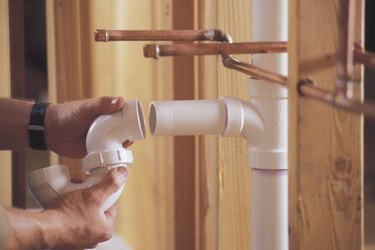
PVC (polyvinyl chloride) pipes are a standard part of the plumbing system in many modern homes, largely because these pipes are so durable. Theoretically, they can last for decades; in reality, PVC pipes do sometimes fail.
Leaks may occur along seams or joints or even from fine cracks in the pipes themselves and may be the result of improper installation or extreme temperatures. Once you discover a puddle under your sink or in your basement, you won't care what caused the leak — just that it gets solved quickly. There are a few DIY solutions that work for a leaking PVC pipe even if the pipe is wet.
Video of the Day
Video of the Day
Evaluate the Leak
PVC pipes can be used throughout a home's plumbing system, so leaks can occur in all kinds of places. Some are easily fixable, while others aren't. So, the first step is to find the source of the leak itself. Finding a puddle or noticing water on a section of pipe doesn't necessarily mean the leak is in that piece of pipe; water may be running down the pipe from a leak that's located somewhere higher up. If you can't find the origin of the leak, can't access the pipe easily, or the leak is in your home's water supply pipe, call a plumber for expert help.
On the other hand, inspecting the leak may help you realize the problem is more easily fixable than you imagined. The leak may be located in a section of removable pipe. For example, the trap under your sink may connect to the pipes on either side of it with simple slip-nut joints, which allows you to easily remove and replace the trap. Using replacement parts is generally preferable to trying to fix leaky parts.
Try a DIY Fix
There are a few good options available to quickly fix leaks in PVC fittings, each with pros and cons. A common method is to stop leaks with tape, which can be effective when the correct product is used. For minor leaks, silicone tape may be sufficient. It sticks to itself rather than the pipe, which means it can be used even when the surface of the pipe is wet. Tightly wrap the tape all around the leak, covering a few inches of the pipe on either side of the leak as well.
Another option is to repair PVC with fiberglass, which hardens to create a sturdy patch over the leak, almost like putting a cast on your pipe. Using fiberglass resin tape is ideal for a wet pipe because the resin is activated by water. Follow package instructions to wet the tape before wrapping it all around the leak. The tape should start to harden within just a few minutes.
Alternatively, epoxy putty can be used to cover leaks in PVC pipes. Choose a product that's designed for use on plastic and that cures in wet conditions. This is a very simple repair option, and it's ideal for leaks in pipes that are hard to reach or can't easily be taped. Simply knead the putty with your fingers and press it over the leak so the entire area is covered and then wait while the putty cures. In an hour or so, it should be rock hard.
Consider Calling a Plumber
Using tape or epoxy putty may fix your leak for many months or even years to come, or the patch could fail, and you could notice the pipe leaking again in the coming weeks. Check the area frequently to see if water is coming from the repaired pipe and call a plumber if you notice your fix isn't holding. For peace of mind, homeowners may want to call in a plumber right after making a temporary fix just in case the leaking pipe is a symptom of a larger issue. For example, if the leaking PVC pipe was improperly installed, there could be improperly installed plumbing in other parts of the home that you want to fix before more leaks occur.